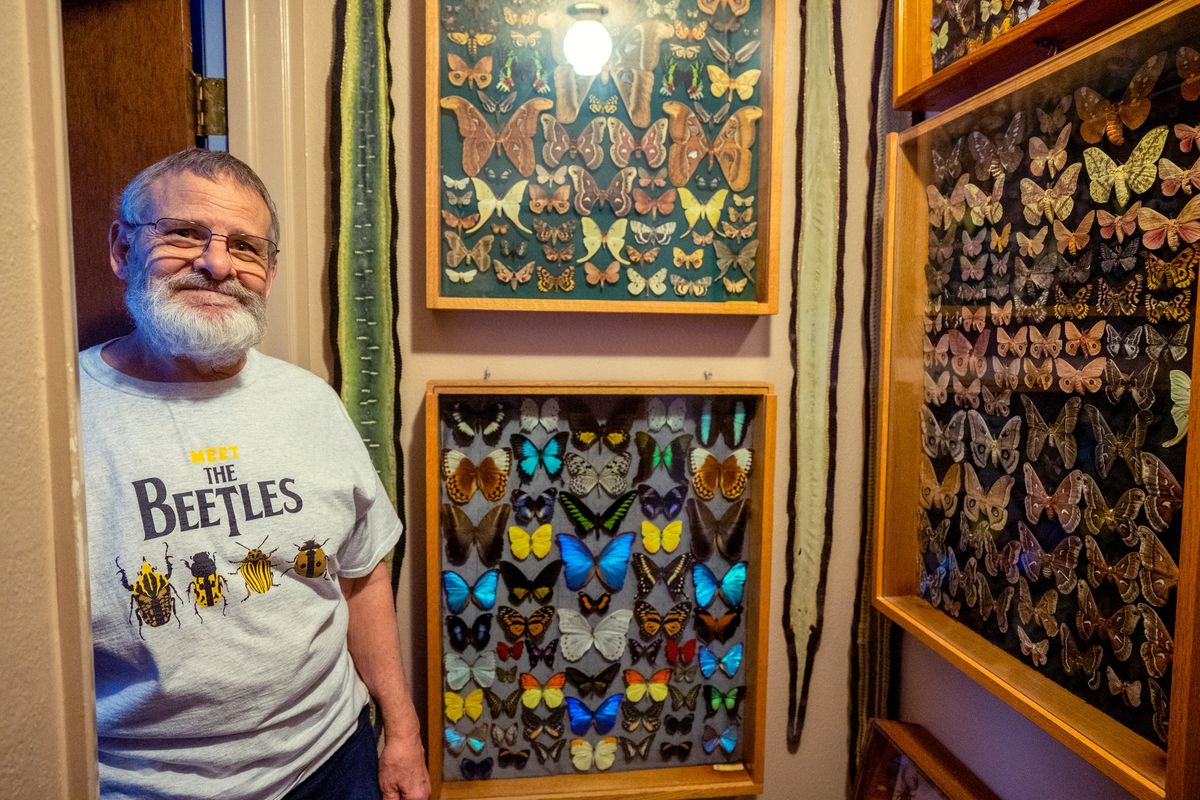The Collector: Doug Beernink bugging to collect butterflies, moths

When Doug Beernink was 5 years old, his sister enlisted his help to collect insects that she needed for a school project. She sent him out with a jar and a butterfly net. Sixty-one years later, he’s still collecting.
“I got it in my blood and couldn’t stop,” he said. “Friends and I ran around with butterfly nets and competed to see who could catch the biggest and the best.”
Wood-framed glass display cases showcase his vast collection of butterflies and moths. He estimates his 25 displays include approximately 1,000 specimens.
He pointed to a selection of monarch butterflies.
“I collected those in 1969,” Beernink said. “My collection is more decorative than scientific.”
Another box features intricately marked giant silk moths.
“I like the big, showy things,” he said.
A selection of brilliant blue morpho butterflies from Ecuador catches the eye.
“I spent five weeks in a dugout canoe in Ecuador in 2000,” he said. “The guide reached up and grabbed a morpho for me. The others were given to me by friends.”
Beernink noted the sometimes subtle differences between butterflies and moths, pointing out that butterflies have long, thin antennae, while moths have shorter, feathery ones.
“Also, butterflies generally gather food during the day while moths are nocturnal,” he said.
Not all of his items have wings. A huge tarantula hangs in a case in his living room.
“I worked at Northwest Seed & Pet for 37 years,” Beernink said. “The tarantula was a customer’s pet and he brought it in after it died.”
A few of his collections are displayed at the store on Sprague Avenue and another at the North Division Street store.
One of his favorite items hangs next to the tarantula – a huge walking stick insect.
“I caught that in Kenya in 1973, when I was on safari with my parents.”
Another case contains scorpions, camel spiders, tarantulas and a large water bug.
While those fascinate him, his favorite display features butterflies and moths found in Washington state.
“I bought some of my cases, but lately I’ve been making them out of old oak pallets,” he said.
There are several specimens he’d love to add to his collection.
“I’ve been looking for an all-yellow or all-black sheep moth, but I’ve never found one,” he said. “You can never catch them all.”
Although he said he’s run out of space to display his finds, he did add a couple of moths to his collection last summer.
“I found them on an old logging road in the Kaniksu National Forest,” he said.
Unfortunately, butterflies and moths are getting harder to find.
“I noticed there’s fewer of them due to increased use of pesticides,” Beernink said. “There were so many more when I was a kid out collecting.”
That’s why he’s much more interested in raising moths than in collecting them. Several cages filled with polyphemus cocoons sit on his patio. Beernink raises a couple of specimens from egg to moth, releasing them into his backyard each June.
“Raising moths reminds me of gardening,” he said. “The ova are like the seed. The caterpillars are like growing plants, but the payoff is the newly emerged moth, much like the beautiful bloom of a fresh new flower.”
It can be a labor-intensive hobby as the growing insects consume a lot of food. Beernink feeds them leaves from his weeping cherry and maple trees.
“I’d like to find someone to take over, so I can give my trees a break,” he said.
But his collection of mounted butterflies and moths gathered over six decades still gives him joy.
“Other people don’t see how beautiful they are,” Beernink said. “To me, they are prettier than a piece of art.”